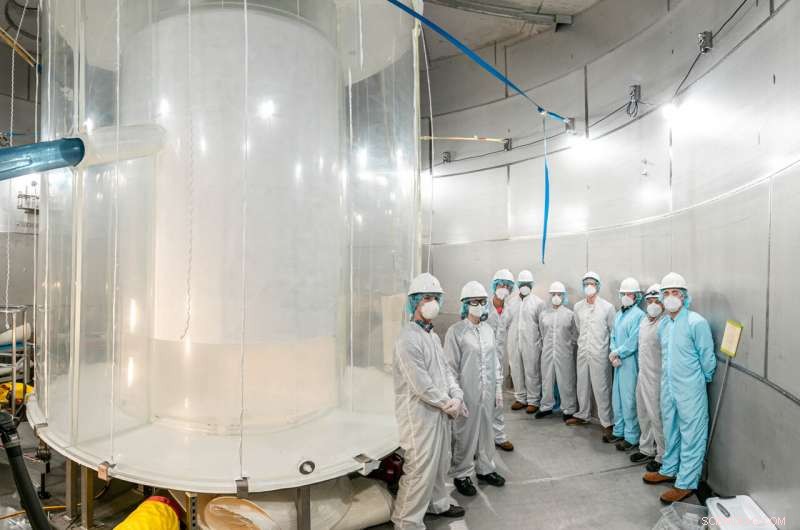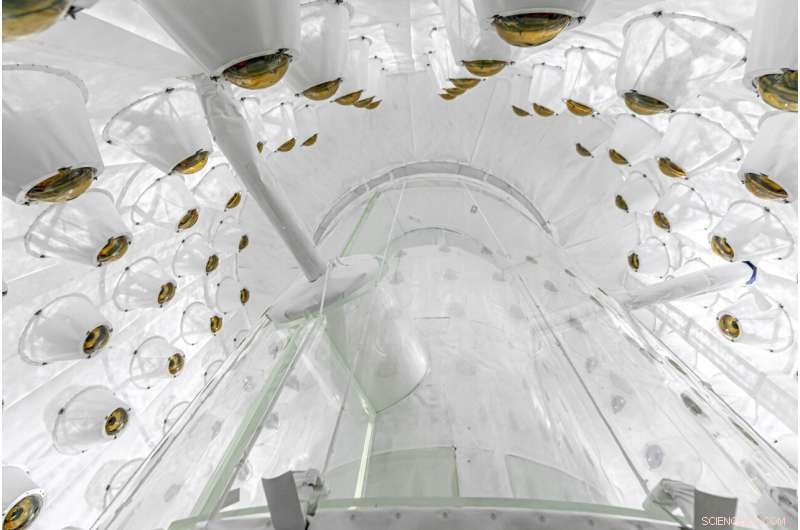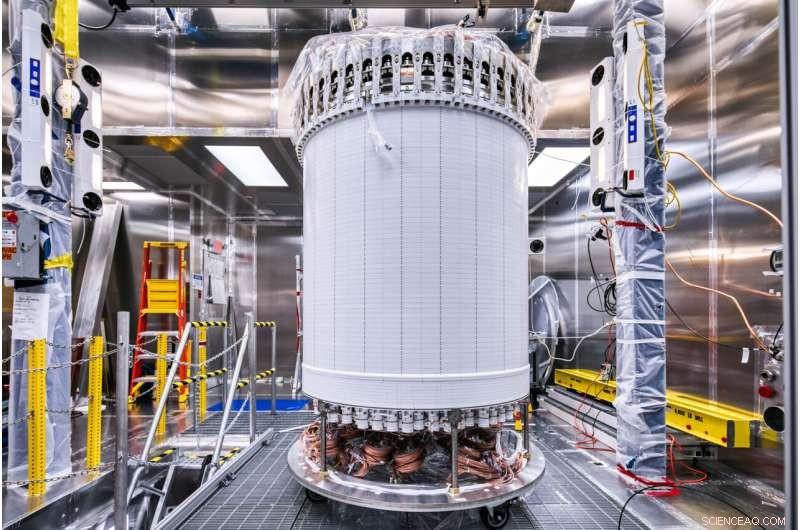
Medlemmar av LZ-teamet i LZ-vattentanken efter den yttre detektorinstallationen. Kredit:Matthew Kapust/Sanford Underground Research Facility
Djupt nedanför Black Hills i South Dakota i Sanford Underground Research Facility (SURF), har en innovativ och unikt känslig mörk materiadetektor – LUX-ZEPLIN (LZ)-experimentet, ledd av Lawrence Berkeley National Lab (Berkeley Lab) – klarat en utcheckningsfasen av uppstartsverksamheten och levererade första resultat.
Meddelandet från denna framgångsrika startup:"Vi är redo och allt ser bra ut", säger Berkeley Labs seniorfysiker och tidigare LZ-talesperson Kevin Lesko. "Det är en komplex detektor med många delar och de fungerar alla väl inom förväntningarna", sa han.
I en tidning som publicerades online idag på experimentets webbplats rapporterar LZ-forskare att med den första körningen är LZ redan världens känsligaste detektor för mörk materia. Tidningen kommer att dyka upp på online-förtrycksarkivet arXiv.org senare idag. LZ talesman Hugh Lippincott vid University of California Santa Barbara sa:"Vi planerar att samla in cirka 20 gånger mer data under de kommande åren, så vi är bara igång. Det finns mycket vetenskap att göra och det är väldigt spännande."
Partiklar av mörk materia har faktiskt aldrig upptäckts - men kanske inte så mycket längre. Nedräkningen kan ha börjat med resultat från LZ:s första 60 "livedays" av tester. Dessa data samlades in under en tre och en halv månads period av inledande operationer med början i slutet av december. Detta var en period som var tillräckligt lång för att bekräfta att alla aspekter av detektorn fungerade väl.
Osynlig, eftersom den inte avger, absorberar eller sprider ljus, är mörk materias närvaro och gravitationskraft ändå grundläggande för vår förståelse av universum. Till exempel formar närvaron av mörk materia, som uppskattas till cirka 85 procent av universums totala massa, formen och rörelsen hos galaxer, och den åberopas av forskare för att förklara vad som är känt om den storskaliga strukturen och expansionen av universum.

Tittar upp i LZ yttre detektorn, som används för att lägga veto mot radioaktivitet som kan efterlikna en mörk materiasignal. Kredit:Matthew Kapust/Sanford Underground Research Facility
Hjärtat i LZ-mörkmateriedetektorn består av två kapslade titantankar fyllda med tio ton mycket ren flytande xenon och ses av två arrayer av fotomultiplikatorrör (PMT) som kan upptäcka svaga ljuskällor. The titanium tanks reside in a larger detector system to catch particles that might mimic a dark matter signal.
"I'm thrilled to see this complex detector ready to address the long-standing issue of what dark matter is made of," said Berkeley Lab Physics Division Director Nathalie Palanque-Delabrouille. "The LZ team now has in hand the most ambitious instrument to do so."
The design, manufacturing, and installation phases of the LZ detector were led by Berkeley Lab project director Gil Gilchriese in conjunction with an international team of 250 scientists and engineers from over 35 institutions from the US, UK, Portugal, and South Korea. The LZ operations manager is Berkeley Lab's Simon Fiorucci. Together, the collaboration is hoping to use the instrument to record the first direct evidence of dark matter, the so-called missing mass of the cosmos.
Henrique Araújo, from Imperial College London, leads the UK groups and previously the last phase of the UK-based ZEPLIN-III program. He worked very closely with the Berkeley team and other colleagues to integrate the international contributions. "We started out with two groups with different outlooks and ended up with a highly tuned orchestra working seamlessly together to deliver a great experiment," Araújo said.
An underground detector
Tucked away about a mile underground at SURF in Lead, S.D., LZ is designed to capture dark matter in the form of weakly interacting massive particles (WIMPs). The experiment is underground to protect it from cosmic radiation at the surface that could drown out dark matter signals.

(Left) A schematic of the LZ detector. (Right) Illustration of LZ operation—particles interact in liquid xenon, releasing a flash of light and charge that are collected by photomultiplier tube arrays at top and bottom. Credit:Left schematic:LZ collaboration. Right image:LZ/SLAC
Particle collisions in the xenon produce visible scintillation or flashes of light, which are recorded by the PMTs, explained Aaron Manalaysay from Berkeley Lab, who as physics coordinator, led the collaboration's efforts to produce these first physics results. "The collaboration worked well together to calibrate and to understand the detector response," Manalaysay said. "Considering we just turned it on a few months ago and during COVID restrictions, it is impressive we have such significant results already."
The collisions will also knock electrons off xenon atoms, sending them to drift to the top of the chamber under an applied electric field where they produce another flash permitting spatial event reconstruction. The characteristics of the scintillation help determine the types of particles interacting in the xenon.
Mike Headley, executive director of SURF Lab, said, "The entire SURF team congratulates the LZ Collaboration in reaching this major milestone. The LZ team has been a wonderful partner and we're proud to host them at SURF."
Fiorucci said the onsite team deserves special praise at this startup milestone, given that the detector was transported underground late in 2019, just before the onset of the COVID-19 pandemic. He said with travel severely restricted, only a few LZ scientists could make the trip to help on site. The team in South Dakota took excellent care of LZ.
"I'd like to second the praise for the team at SURF and would also like to express gratitude to the large number of people who provided remote support throughout the construction, commissioning and operations of LZ, many of whom worked full time from their home institutions making sure the experiment would be a success and continue to do so now," said Tomasz Biesiadzinski of SLAC, the LZ detector operations manager.

The LZ central detector in the clean room at Sanford Underground Research Facility after assembly, before beginning its journey underground. Credit:Matthew Kapust, Sanford Underground Research Facility
"Lots of subsystems started to come together as we started taking data for detector commissioning, calibrations and science running. Turning on a new experiment is challenging, but we have a great LZ team that worked closely together to get us through the early stages of understanding our detector," said David Woodward from Pennsylvania State University, who coordinates the detector run planning.
Maria Elena Monzani of SLAC, the Deputy Operations Manager for Computing and Software, said, "We had amazing scientists and software developers throughout the collaboration, who tirelessly supported data movement, data processing, and simulations, allowing for a flawless commissioning of the detector. The support of NERSC [National Energy Research Scientific Computing Center] was invaluable."
With confirmation that LZ and its systems are operating successfully, Lesko said, it is time for full-scale observations to begin in hopes that a dark matter particle will collide with a xenon atom in the LZ detector very soon. + Utforska vidare